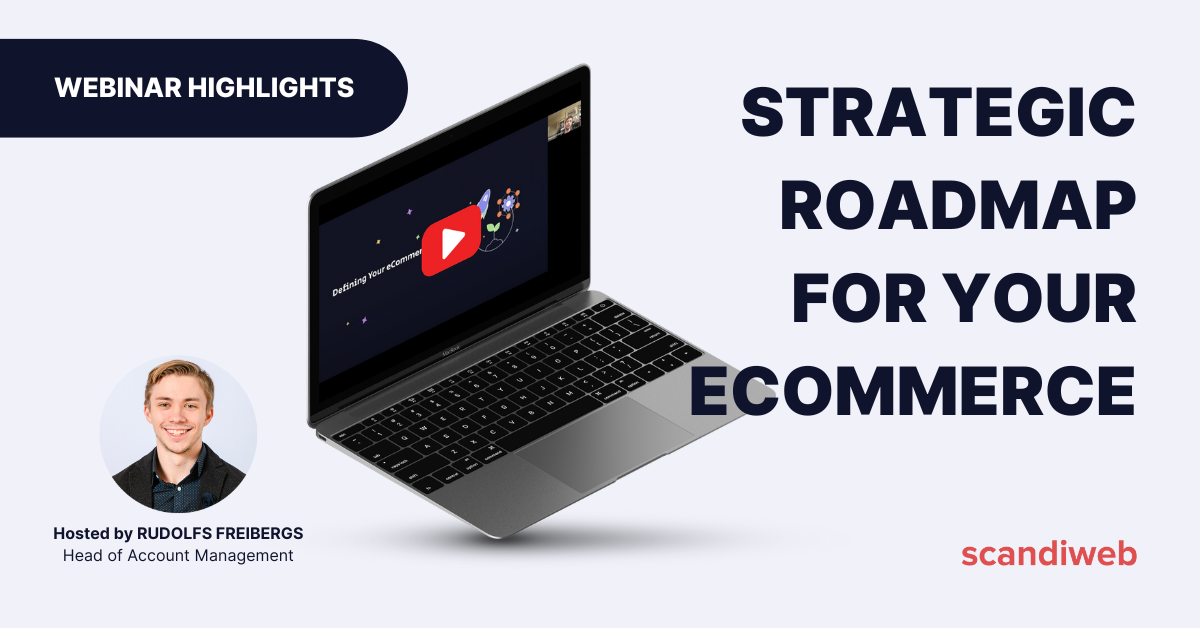An effective eCommerce strategy is critical for any retailer today to stay ahead of the competition and meet customer needs. In scandiweb, we’ve crafted and realized milestone-focused strategic roadmaps for 20+ eCommerce companies based on three strategic pillars: digital ecosystem, customer lifecycle, and customer experience. Rudolfs Freibergs, scandiweb’s Head of Account Management, recently hosted a webinar and shared insights into building a robust eCommerce strategy roadmap and setting long-term business goals that come to life.
Here are the key highlights from the webinar!
Define your eCommerce strategy
The first step is to define your eCommerce strategy at a high level. Conduct a SWOT analysis to identify your strengths, weaknesses, opportunities, and threats. Determine key stakeholders and understand your market and customers through data and user research. The recommendation shared in the webinar was conducting user interviews to directly inform your strategy.
Identify and address data gaps
While developing your strategy, look for any data gaps, like a lack of competitor analysis or customer insights. To fill these gaps, scan industry reports and benchmarks to see trends. User interviews and surveys are also helpful here. Having a data-driven strategy will make it much more effective.
Build your roadmap in quarters
With your strategy and data in place, you can build a practical roadmap to execute the strategy in quarters over the next 1-2 years. Make sure your roadmap is ambitious enough to drive growth but also realistic based on your resources and capabilities.
Consider the full eCommerce ecosystem
Your roadmap should cover the entire eCommerce ecosystem, from acquisition to loyalty and technology. Rudolfs evaluated over 230 indicators across 15 components in 4 core areas: acquisition, purchase, loyalty, and technology. Keep your customers at the center of all components.
Watch these trends
There are several trends retailers should consider incorporating into their eCommerce roadmaps:
- Influencer marketing and user-generated content to boost brand awareness
- Zero-party data, where customers share data willingly to enable personalization
- AI for SEO to optimize search rankings
- 3D configurators to showcase products from all angles
- Live shopping to demonstrate products in real-time videos
- Hyperpersonalization powered by data and AI
- Sustainability initiatives to reduce environmental impact
Evaluate your technology
On the technology side, follow trends like:
- Core Web Vitals to improve site performance
- Progressive Web Apps (PWAs) for an app-like experience
- AI to reduce costs through automation
- Localization to tailor the experience based on location
- Chatbots to provide convenience and support
Build loyalty
Personalize rewards and offers and provide perks and subscription programs. Loyalty is key to retention and lifetime customer value.
In summary, retailers should focus on automation and data to reduce costs, improve experiences through AI, and unlock new opportunities to better serve customers. An eCommerce strategy roadmap that follows the latest trends and best practices can help retailers boost key metrics and gain a competitive edge.
Feeling vague about your eCommerce future? Get your eCommerce roadmap for the next 3-5 years with scandiweb and reach the most ambitious business goals!


Share on: